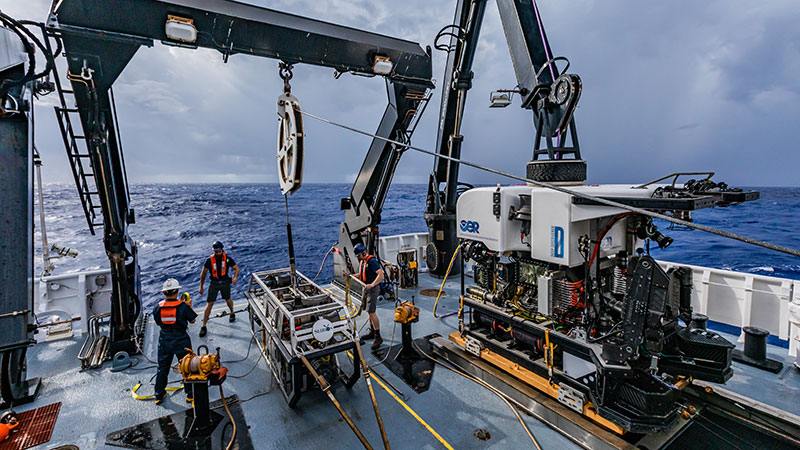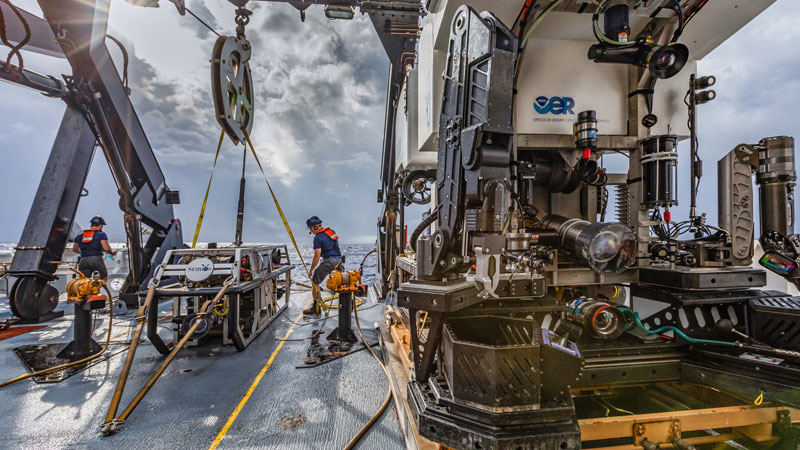What Is a Shakedown?
A shakedown is an expedition that tests a ship’s mission systems and equipment before a field season.

Mission systems like remotely operated vehicles Deep Discoverer and Seirios undergo rigorous testing during shakedown expeditions at the beginning of each field season on NOAA Ship Okeanos Explorer. Image courtesy of NOAA Ocean Exploration, Windows to the Deep 2018. Download image (jpg, 17.7 MB).
NOAA Ocean Exploration starts every field season on NOAA Ship Okeanos Explorer with an at-sea “shakedown” to make sure the mapping, remotely operated vehicle (ROV), telepresence, positioning, and other important systems needed to conduct scientific activities are working properly. Shakedowns simulate typical at-sea operations, which enables us to identify and correct problems with existing systems and equipment, test new systems and equipment, and train new staff. Shakedowns are critical to ensuring quality data collection and successful expeditions.
While all aspects of science operations are tested, the focus of a shakedown is usually on the mapping and ROV systems. These systems may be tested on a single expedition or two individual expeditions.
Mapping Shakedowns
During the off-season, work is conducted on the ship that may affect sensor positioning and alignment and introduce errors during data collection. These errors are identified and resolved as part of a mapping shakedown, during which the mappers calibrate and evaluate the performance of the systems used for seafloor and water column mapping to ensure the collection of accurate, high-quality mapping data.
Among these activities is the geometric calibration of the multibeam sonar system through a procedure commonly referred to as a "patch test." A patch test involves collecting multibeam data over a previously mapped area with a flat bottom and steep slope (and/or a well-defined feature such as a rock outcrop or shipwreck). These data are used to identify differences in timing, pitch, roll, and heading reported by the sensors, and to resolve errors accordingly. A correctly calibrated system will return results that match the existing data and are repeatable across multiple tests.
A mapping shakedown typically also includes testing of the sound speed sensors, split-beam sonars, the sub-bottom profiler, and the acoustic Doppler current profilers.
ROV Shakedowns
An ROV shakedown is designed to stress test every component of the two-body ROV system (ROVs Deep Discoverer and Seirios) and their associated systems to ensure they are performing properly and are ready to be put to work. Given the complexity of the systems, it’s not unusual to encounter glitches that need to be fixed. It takes a variety of engineers (mechanical, electrical, broadcast, network, telepresence, and software) working together to get the ROV systems in working order.
During an ROV shakedown, the ROVs are typically deployed for a series of dives to depths ranging from 250 to 3,000 meters (820 to 9,843 feet) over a variety of seafloor types to test the functionality of onboard sensors, cameras, and other important components. During a dive, all the vehicles’ systems are monitored while they’re descending to ensure that everything is running smoothly. Once the ROVs reach the seafloor, the engineers perform a series of tests to assess and troubleshoot mechanical, electrical, and software systems on the vehicles, with a focus on newly installed or rebuilt equipment.
ROV shakedowns are also used to try out new equipment and techniques. And, they give ROV pilots time to practice piloting Deep Discoverer and using its sample collection tools without the normal operational pressures of a science-focused dive.
Other systems tested during an ROV shakedown include the telepresence system and the acoustic positioning system, which helps the ROV pilots avoid fragile, sensitive, and potentially hazardous seafloor features.
Published April 7, 2023
Last updated August 21, 2024
Relevant Expedition: 2023 Shakedown + EXPRESS West Coast Exploration

